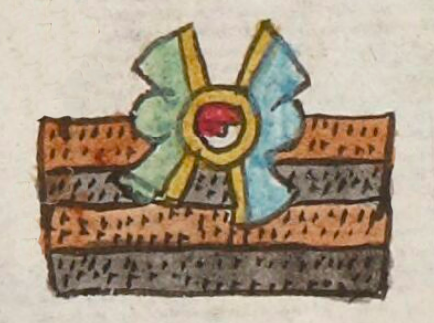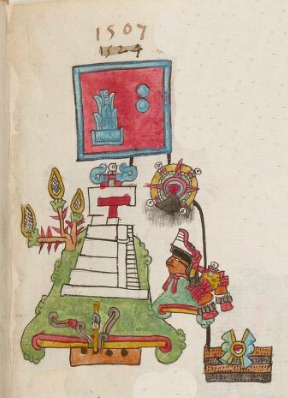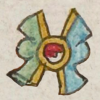tlalolin (TR42r)
This compound glyph represents the noun tlalolin, "earthquake." The two principal elements are a rectangle representing land (tlalli) and, hovering above and in front of the tlalli sign, the quincunx-like sign for movement or earthquake (olin). Tlalli can mean not just land, but also the Earth. In this tlalli sign there are four strips seemingly under cultivation (dotted), and they alternate in color between terracotta and dark brown. The olin sign is an X shape with outer lobes and an interior stellar eye.
Stephanie Wood
Another olin sign in this collection has a rectangular, dotted sign behind it, and that one, too, may refer specifically to the type of movement that is an earthquake, as this one does. More often, the olin sign is not visually "grounded," we might say. The shape of the olin sign will vary greatly, sometimes with lobes and sometimes with rings outside the X shape. The center can be simply a circle, and sometimes a stellar eye. The Matrícula de Huexotzinco someimes includes a rubber ball (olli) at the center, providing a phonetic complement to the olin. In this manuscript (Telleriano-Remensis) and in the Codex Mendoza, the colors of olin will vary widely. One TR olin has a vertical huitztli axis in the middle of the X.
Stephanie Wood
tenblolatierra
tembló la tierra
Stephanie Wood
1578
Jeff Haskett-Wood
earthquakes, quakes, temblores, terremotos

tlalolin, earthquake, https://nahuatl.wired-humanities.org/content/tlalolin
tlalolini, the earth moves, https://nahuatl.wired-humanities.org/content/tlalolini
ol(in), movement, earthquake, https://nahuatl.wired-humanities.org/content/olin
la tierra tembló
Stephanie Wood
The Codex Telleriano-Remensis is hosted on line by the Bibliothèque nationale de France.
https://gallica.bnf.fr/ark:/12148/btv1b8458267s/f109.item. We have taken this detail shot from the indicated folio.
This manuscript is not copyright protected, but please cite Gallica, the digital library of the Bibliothèque nationale de France or cite this Visual Lexicon of Aztec Hieroglyphs, ed. Stephanie Wood (Eugene, Ore.: Wired Humanities Projects, 2020–present).








